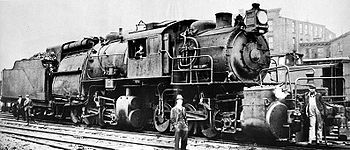Camelback locomotive

A camelback locomotive is a type of steam locomotive with the driving cab placed in the middle, astride the boiler. This placement was done to improve driver visibility; camelbacks were fitted with wide fireboxes which would have severely restricted driver visibility from the normal cab location at the rear. Camelbacks were also known as Mother Hubbards or center-cab locomotives.
Development
The camelback design was developed separately by two different railroads in different eras. Though the name is common to both designs they had little in common other than the placement of the cab.
Early Use
The camelback type locomotive came about in 1877, the creator of the camelback locomotive, John E. Wootten was the Superintendent of Motive Power for the then Philadelphia and Reading Railroad (later simply the Reading Railroad) from 1866, patented the Wooten firebox.
There were locomotives on the B&O called Winans Camels, which people who know little about the history and design of steam locomotives confuse with camelbacks.
They are not camelbacks because they have cabs that sit on top of the locomotive's boiler unlike actual camelback locomotives, which have cabs that straddle their boiler. They also were designed and built with long narrow fireboxes to use soft bituminous coal, unlike camelbacks which were designed and built with tall and wide fireboxes to burn hard slow burning anthracite coal efficiently.
These are the defining feature between this very different types of locomotives.
The Wootten Firebox

John E. Wootten developed the Wootten firebox to effectively burn anthracite waste, which was a possible plentiful, cheap source of fuel. Wootten determined that a large, wide firebox would work best. As the successful trailing truck used to support large fireboxes had not yet been developed, Wootten instead mounted his huge firebox above the locomotive's driving wheels. The problem now arose that with a cab floor at the then standard tender deck height, it would be impossible for the locomotive's engineer to see forwards around the firebox shoulders. Instead, a cab for the engineer was placed above and astride the boiler. The fireman, however, remained at the rear with minimal protection from the elements. This gave rise to the unusual shape of the camelbacks.
First Camelbacks
The first camelback, a 4-6-0, was built in early 1877 by the P&R's Reading, Pennsylvania shops. It proved a success; the fuel cost saving was about $2,000 a year (approx. $30,000 now). More were built for many of the railroads operating in the anthracite regions, and some others, of many different wheel arrangements. The largest ones had a 0-8-8-0 arrangement and were the only articulated camelbacks built.
Safety problems
The camelback was not a very safe design for its crew. The engineer was perched above the whirling siderods, vulnerable to swinging and flying metal if anything below should break. The fireman, meanwhile, was alone and exposed to the elements at the rear. The Interstate Commerce Commission banned further construction of camelbacks, but gave exceptions to allow some to be completed. In 1927, further orders were completely prohibited on grounds of safety.
Many camelbacks were converted into end-cab locomotives; the advent of the mechanical stoker and its associated underfloor machinery placed cab floors and tender decks higher, and from that vantage point the engineer could see ahead.
Survivors
Owning railroads
- Atchison, Topeka and Santa Fe Railway
- Baltimore and Ohio Railroad
- Canadian Pacific Railway
- Central Railroad of New Jersey
- Chicago and Eastern Illinois Railroad
- Chicago and Indiana Coal Railroad
- Delaware and Hudson Railway
- Delaware, Lackawanna and Western Railroad
- Erie Railroad
- Lehigh and Hudson River Railway
- Lehigh and New England Railroad
- Lehigh Valley Railroad
- Long Island Rail Road
- Maine Central Railroad
- Missouri-Kansas-Texas Railroad
- Nashville, Chattanooga and St. Louis Railroad
- New York, Ontario and Western Railroad
- New York, Susquehanna and Western Railway
- Pennsylvania Railroad
- Reading Railroad
- Staten Island Rapid Transit
- Southern Pacific Railroad
- Union Pacific Railroad
- Wheeling and Lake Erie Railway
References
- Barris, Wes. Camelback Locomotives. Retrieved from http://www.steamlocomotive.com/camelback/ on 2004-12-10.
- Sagle, Lawrence W. B&O Power: Steam, Diesel and Electric Power of the Baltimore and Ohio Railroad 1829 - 1964, Alvin F. Staufer, 1964
